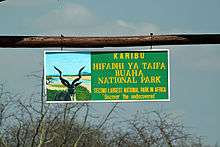Ruaha National Park
| Ruaha National Park | |
|---|---|
|
IUCN category II (national park) | |
 | |
 | |
| Location | Tanzania |
| Nearest city | Iringa |
| Coordinates | 7°30′S 35°00′E / 7.500°S 35.000°ECoordinates: 7°30′S 35°00′E / 7.500°S 35.000°E |
| Area | 20,226 km2 (7,809 sq mi) |
| Established | 1964 |
| Visitors | 21,267 (in 2012[1]) |
| Governing body | Tanzania National Parks Authority |
Ruaha National Park is the largest national park in Tanzania. The addition of the Usangu Game Reserve and other important wetlands to the park in 2008 increased its size to about 20,226 square kilometres (7,809 sq mi), making it the largest park in Tanzania and East Africa.[2]
The park is situated in central Tanzania between latitude 7 and 8° S and longitude 34 and 35° E about 130 kilometres (81 mi) west of Iringa.[2] The park is a part of the 45,000 square kilometres (17,000 sq mi) Rungwa-Kizigo-Muhesi ecosystem,[2] which includes Rungwa Game Reserve, Kizigo and Muhesi Game Reserves, the Mbomipa Wildlife Management Area,[3] and several other protected areas.
The name of the park is derived from the Great Ruaha River, which flows along its southeastern margin and is the focus for game-viewing. The park can be reached by car on a dirt road from Iringa and there are two airstrips – Msembe airstrip at Msembe (park headquarters), and Jongomeru Airstrip, near the Jongomeru Ranger Post.[2]
History
Germany gazetted the Saba Game Reserve in 1910.[2] British colonial authorities changed the name to the Rungwa Game Reserve in 1946.[2] In 1964, the southern portion of the reserve was excised and elevated to full park status.[2] The most recent addition to the park was the former Usangu Game Reserve in 2008.
Wildlife
The park is noted for its large elephant population,[2] with about 10,000 roaming here. More than 571 species of birds have been identified in the park.[2] Among the resident species are hornbills,[2] kingfishers, and sunbirds. Many migratory birds visit the park,[2] e.g., the white stork.
Other noted animals found in this park are cheetah, leopard, lion, African wild dog, giraffe, hippopotamus, Cape buffalo, and sable antelope.[2] The rhinoceros population was last sighted in 1982 and are most likely extinct in the park due to poaching.
The best times to visit for predators and large mammals is during the dry season (May–December) and for birds and flowers, during the wet season (January–April).[2]
Environmental change
The park is currently facing a significant environmental challenge from the progressive drying up of the Great Ruaha River. The river used to flow all year round, but since 1993 there have been increasingly long periods every dry season in which it has dried up completely. Different hypotheses have been advanced to account for this, and one view is that it is caused by the expansion of irrigation schemes for rice cultivation and growth of livestock keeping in the Usangu wetland, which feeds the Great Ruaha River (Fox 2004).
Accommodation
There is a wide selection of accommodation in or near the park. The only lodge inside the park is the Ruaha River Lodge.[2] There are also permanent or seasonal tented camps inside the park.[2] There are also several park-operated public and special campsites, a hostel, self-catering bandas, and cottages.[2] Just outside the park boundaries are several accommodation facilities.[2]
Gallery
 Ruaha Gorge
Ruaha Gorge Entrance
Entrance Boundary
Boundary River
River Superb starling (Lamprotornis superbus)
Superb starling (Lamprotornis superbus) Elephants at sunset
Elephants at sunset
References
- ↑ "Tanzania National parks Corporate Information". Tanzania Parks. TANAPA. Retrieved 22 December 2015.
- 1 2 3 4 5 6 7 8 9 10 11 12 13 14 15 16 17 Ruaha National Park, Official Website, Tanzania National Parks, accessed 23 November 2014. Tanzaniaparks.com. Retrieved on 2016-09-14.
- ↑ Mbomipa Wildlife Management Area. Twma.co.tz. Retrieved on 2016-09-14.
External links
| Wikimedia Commons has media related to Ruaha National Park. |